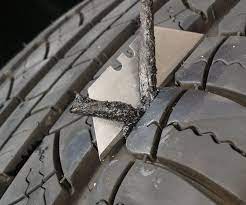Discovering a nail or sharp object embedded in your tire can be a frustrating experience. In such situations, a common solution is to have the tire repaired by a professional who may use a plug on tire. But how long does a plugged tire last? In this article, we will delve into the topic and explore the longevity of a plug on a tire, factors that influence its lifespan, and the importance of proper tire maintenance. By understanding these aspects, you’ll be better equipped to make informed decisions and ensure your safety on the road.
Understanding Tire Plugs and Their Function
Before going into how long does a plugged tire last, lets discuss the functions of tire plug. A tire plug is a repair method used to seal punctures caused by nails, screws, or other objects that have penetrated the tire tread. It involves inserting a rubber plug into the puncture hole, effectively blocking air leakage and allowing the tire to maintain proper inflation pressure.
How Long Does a Plugged Tire Last?
The lifespan of a plugged tire can vary depending on several factors, including the size and location of the puncture, driving conditions, and maintenance practices. In general, a properly plugged tire can last for thousands of miles without any issues. However, it is important to monitor the plugged tire closely and be aware of any signs of damage or failure.
Factors Affecting the Longevity of a Plugged Tire

Following factors help us to decide how long does a plugged tire last?
- Puncture Size and Location: The size and location of the puncture play a crucial role in determining how long does a plugged tire last. Smaller punctures, particularly in the central area of the tread, are more likely to provide a successful and durable repair.
- Driving Conditions: Driving conditions such as rough roads, potholes, and debris-laden areas can put additional stress on a plugged tire. Aggressive driving habits, such as sudden braking or sharp turns, can also impact the tire’s lifespan.
- Maintenance Practices: Maintenance practice is a most common factor which decide how long does a plugged tire last? Proper tire maintenance, including regular inflation checks, rotation, and alignment, can significantly extend the lifespan of a plugged tire. Neglecting these maintenance tasks can lead to uneven wear and reduce the tire’s overall durability.
The Importance of Proper Tire Maintenance

Regardless of whether your tire has been plugged or not, proper tire maintenance is essential for ensuring safety and maximizing tire lifespan. Regularly inspect your tires for signs of damage, maintain proper inflation pressure, rotate them as recommended by the manufacturer, and ensure proper wheel alignment. By following these practices, you can help extend the life of your tires and minimize the risk of tire-related issues.
Signs of Tire Damage or Failure

While a plugged tire can provide reliable performance, it is important to be vigilant for signs of damage or failure. Watch out for the following indicators that may suggest the need for immediate attention or tire replacement:
- Bulges, bubbles, or sidewall damage
- Uneven tread wear
- Loss of air pressure
- Excessive vibration or shaking while driving
- Visible cords or steel belts
If you notice any of these signs, it is crucial to have your tire inspected by a professional and consider replacing it if necessary.
When to Replace a Plugged Tire
While a properly plugged tire can last a significant amount of time, it is generally recommended to replace it when the tire reaches the end of its tread life or when multiple punctures occur in close proximity. It’s important to prioritize safety and consult with a tire professional who can assess the condition of the tire and provide appropriate guidance.
How to Extend the Lifespan of a Plugged Tire
To maximize the lifespan of a plugged tire, consider the following tips:
- Practice Defensive Driving: Avoid rough road conditions, potholes, and sharp objects whenever possible. Drive cautiously to minimize the risk of punctures and tire damage.
- Regularly Monitor Tire Pressure: Check your tire pressure regularly and maintain it at the recommended level. Proper inflation helps ensure even wear and extends tire life.
- Rotate and Align Tires: Follow the manufacturer’s recommendations for tire rotation and wheel alignment. This helps promote even tread wear and enhances tire longevity.
- Inspect Tires Frequently: Regularly inspect your tires for signs of damage, such as punctures, bulges, or uneven wear. Address any issues promptly to prevent further damage or tire failure.
- Seek Professional Assistance: If you have concerns about the plugged tire or notice any abnormal signs, consult a tire professional for inspection and advice.
Tire Plug vs Patch
When it comes to repairing a tire, there are two common methods: tire plug and tire patch.
- Tire Plug: A tire plug involves inserting a rubber plug into the puncture hole to seal it. It provides a temporary fix and is quick and inexpensive to perform. However, it may not be suitable for larger punctures or damage to the sidewall.
- Tire Patch: A tire patch is a more comprehensive repair method. It involves applying a patch to the inner lining of the tire, covering the puncture from the inside. It provides a more durable and long-lasting solution, particularly for larger punctures or damage.
- Effectiveness: While both methods can effectively seal punctures, a properly applied tire patch is generally considered to provide a more reliable and permanent repair.
Conclusion
In conclusion, a properly plugged tire can provide reliable service for thousands of miles. However, it is essential to consider the size and location of the puncture, driving conditions, and proper tire maintenance. Regularly inspect your tires, monitor for signs of damage or failure, and consult with a tire professional when needed. By taking these measures, you can ensure how long does a plugged tire last and maintain a safe driving experience.
Common FAQs About Plugged Tires
How long does a plugged tire last on a highway?
The lifespan of a plugged tire on a highway can vary depending on factors such as driving conditions, tire maintenance, and the size and location of the puncture. Generally, a properly plugged tire can last for thousands of miles on the highway without any issues.
Is it safe to drive on a plugged tire?
Driving on a properly plugged tire is generally safe. However, it is essential to monitor the tire closely for any signs of damage or failure.
Is plugging a tire a permanent fix?
Plugging a tire is considered a temporary or interim fix rather than a permanent solution. It is recommended to replace the tire or seek professional inspection and repair for a long-term resolution.
Can I drive on a plugged tire for a week?
Driving on a properly plugged tire for a week is generally considered safe, as long as there are no signs of damage or loss of tire pressure. However, it is important to monitor the tire closely and consider getting it inspected by a professional as soon as possible.
How long does a tire plug last?
The lifespan of a tire plug can vary depending on factors such as the size and location of the puncture, driving conditions, and tire maintenance. Generally, a properly installed tire plug can last for thousands of miles without any issues.
